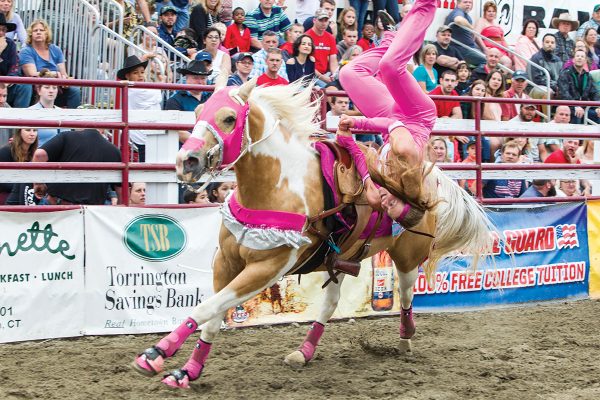
It’s easy to be captivated by trick riding: Picture bright, sparkly outfits adorning athletic riders with fancy horses galloping around the arena. Rarely does the rider stay in the saddle for longer than a second: She’s flipping over the horse, hanging off the side and then standing on the seat of her saddle, yet the horse never slows down.
The sport caught the attention of Kelsey Gascon in a demonstration at BreyerFest the summer before she started college. She immediately knew that’s what she wanted to do.
While in college, Kelsey attended a Trick Riding 101 clinic hosted by Shelby Peterson of the Trixie Chicks, a trick riding group based in the South, and she jumped headfirst into the sport. After college, she got her start with the Trixie Chicks. But trick riding is a sport that’s as dangerous as it is awe-inspiring.
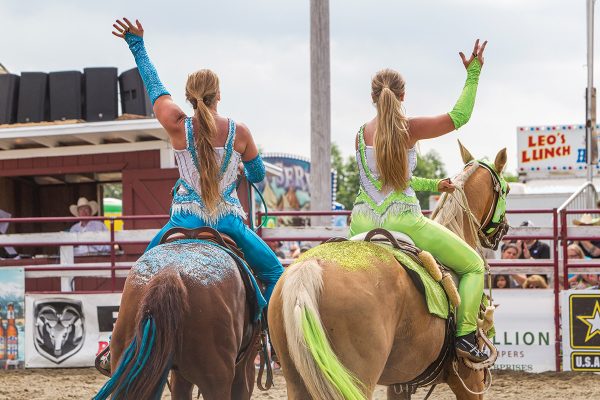
How Do You Get Started?
Trick riding basics include a professional instructor, a trick riding saddle, and a well-trained horse.
Seems like any other riding discipline, right? But there are some big differences between western or English and trick riding.
“What I didn’t know at first was that there are fewer than 50 professionals in the world that do trick riding as a full-time job,” Kelsey says.
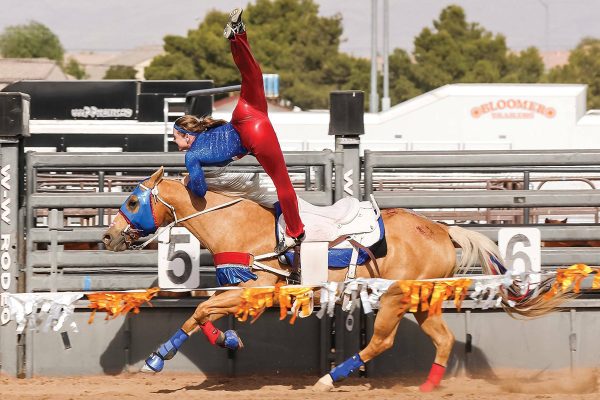
This meant that finding the right professional that performs the sport safely and is a suitable trainer was going to be difficult for a young rider to do. Kelsey drove 14 hours to a three-day clinic in Colorado while attending college. She later received permission from Shelby to watch the Trixie Chicks practice and start learning tricks.
As difficult as it was to find an instructor, it’s just as difficult to find the right equipment and the right horse for the event.
“The downside to trick riding is that there aren’t a lot of people who do it,” Kelsey says. “There are very few safe saddle makers out there, and as far as finding the right horse, that can be even harder. If a trick rider has a good horse, she won’t sell him. Nobody is out there just training trick riding horses to sell because it takes so much work to get the bond with the horse to do the things we do.”
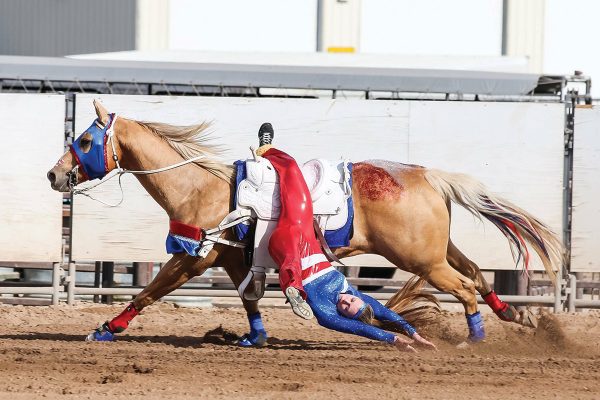
Currently, there isn’t a regulating association for trick riders in the United States. About six years ago, there was a North American Trick Riding Championship, which Kelsey won, but after a few years of that circuit, it was disbanded. However, Kelsey is working on a foundation for a national association that she hopes to pursue when she’s ready to retire from competing.
Who Can Trick Ride?
Kelsey works with a wide variety of students, with the youngest at only 4 years old and the oldest being 62. She says that as long as you have the drive to work hard, anyone can be a trick rider.
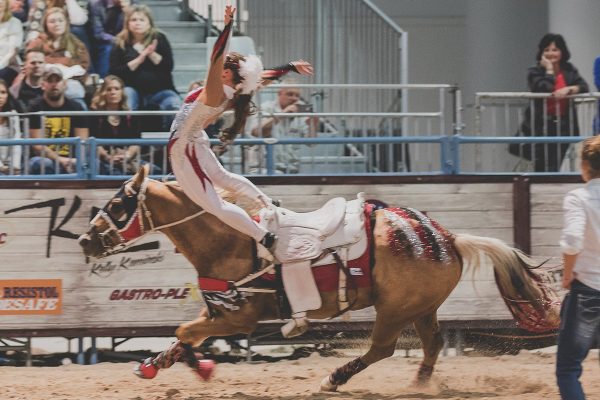
On top of being fearless and a good rider, trick riders must be flexible and physically strong, especially in their core and upper body.
“It’s very physically demanding,” she says. “You use every part of your body.”
Riders wear flexible, tight-fitting clothing that’s brightly colored and flashy. The flash is for the style points, and the fit is for safety—the saddle horn of the trick riding saddle is much higher than a typical western saddle, which means a loose item can easily get caught on the horn.
Instead of rigid cowboy boots, trick riders wear wrestling shoes because they offer ankle support while having a soft sole to allow for pointed toes and easy flexing.
Can My Horse Do Trick Riding?
Most trick riding horses are stock-type horses, such as American Quarter Horses or Paint Horses, though Kelsey has occasionally competed on Paso Finos.
“Paso Finos make phenomenal trick riding horses,” she says. Her husband, Michael Gascon, is a very successful Paso Fino exhibitor and trainer, so most don’t get to stay in her program for very long.
“The horse has to be willing to handle a very tight front and back cinch while having someone hang off the side of him, all while free-running at speed in an arena,” Kelsey says. “In trick riding, you’re going as fast as you can in the pattern. You’ve taught the horse to run this pattern and you don’t have control—you’ve dropped the reins and you let him choose and rate his own speed.”
Is Trick Riding for Me?
Adrenaline junkies who are interested in the sport of trick riding need to be aware of the dangers associated with the sport, Kelsey warns.
“Not to discourage anyone, but if you have a daughter or a son interested in the sport, it’s not a matter of if you get hurt, it’s when and how badly you get hurt,” she says. “You do everything you can to prepare yourself, prepare your horse, and do everything safely, and at the end of the day you must understand that what you’re doing is gymnastics on the back of a free-running horse. You just try to make sure that you take the safety precautions, build an amazing relationship with your horse, and have some really good training into your horse. And be mindful.”
Kelsey says that right now the hardest part of trick riding is that the popularity of the sport and the number of trick riders is bigger than it’s ever been, thanks in part to social media. It seems more accessible, and people are more interested in doing it. However, since there are not a lot of instructors doing clinics, there are more kids getting hurt because they’re trying to be self-taught.
“This is not a sport that you can just watch videos of and teach yourself,” she warns. “Every horse, every rider, and every trick is going to be fitted a different way to make sure both the horse and rider stay safe. This is not something that you just learn by watching, unfortunately.”
Riders interested in learning more about the sport are encouraged to check out the Trixie Chicks’ website and reach out to Kelsey and Shelby. They will try to put you in touch with a trainer and help get you started on the right foot!
This article about trick riding appeared in the March/April 2023 issue of Young Rider magazine. Click here to subscribe!


